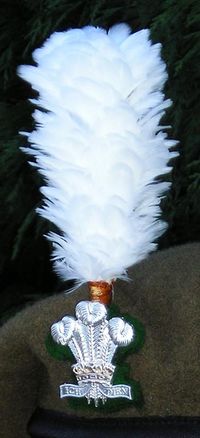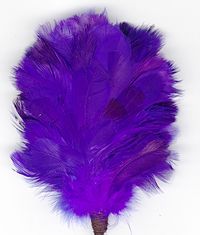Hackle: Difference between revisions
No edit summary |
|||
| (5 intermediate revisions by 2 users not shown) | |||
| Line 1: | Line 1: | ||
[[Image:CroppedORsBeret.jpg|200px|right|thumb|The new cap badge, with hackle, for soldiers of the Royal Welsh Regiment of the British Army. Hackles are worn in many different shapes, sizes and colours dependent on Regimental tradition.]] | |||
A '''Hackle''' is a feather plume attached to the headdress by some units of the Canadian Army in certain circumstances as described below. Hackles are neither "battle honours" nor are they worn as a sign of disgrace, as many urban legends have described. They are also not to be confused with white feathers, which during the First World War were sometimes pinned to the jackets of young men who had not enlisted for military service; the young ladies performing the pinning felt the feather was a suitable mark of cowardice. | A '''Hackle''' is a feather plume attached to the headdress by some units of the Canadian Army in certain circumstances as described below. Hackles are neither "battle honours" nor are they worn as a sign of disgrace, as many urban legends have described. They are also not to be confused with white feathers, which during the First World War were sometimes pinned to the jackets of young men who had not enlisted for military service; the young ladies performing the pinning felt the feather was a suitable mark of cowardice. | ||
| Line 12: | Line 13: | ||
==Queen's Own Cameron Highlanders of Canada and Cameron Highlanders of Ottawa== | ==Queen's Own Cameron Highlanders of Canada and Cameron Highlanders of Ottawa== | ||
[[Image:Hackle Cameron Highlanders of Canada.jpg|right|200px|thumb|Blue hackle as worn by the QOCH and Cam H of O.]] | |||
Both Canadian regiments of Camerons adopted the blue hackle after the Second World War, as their namesake unit of the British Army (The Queen's Own Cameron Highlanders) had adopted the blue hackle in 1939. When it was learned the kilt was no longer to be worn in action, the CO of one of the Cameron battalions asked the king for permission to wear a hackle as a distinction; the King suggested royal blue. hackle.[http://www.canadiansoldiers.com/mediawiki-1.5.5/index.php?title=Blue_Hackle] | Both Canadian regiments of Camerons adopted the blue hackle after the Second World War, as their namesake unit of the British Army (The Queen's Own Cameron Highlanders) had adopted the blue hackle in 1939. When it was learned the kilt was no longer to be worn in action, the CO of one of the Cameron battalions asked the king for permission to wear a hackle as a distinction; the King suggested royal blue. hackle.[http://www.canadiansoldiers.com/mediawiki-1.5.5/index.php?title=Blue_Hackle] | ||
| Line 18: | Line 20: | ||
==Pipe Bands== | ==Pipe Bands== | ||
The feather bonnet worn in full dress by many military pipe bands also includes a hackle. | {| | ||
|[[Image:Featherbonnet.jpg]] | |||
|The feather bonnet worn in full dress by many military pipe bands also includes a hackle. At left, the Drum Major of [[The Calgary Highlanders]] photographed at a regimental change of command parade in 1982. The cap badge on the feather bonnet is worn on the left side of the headdress; the white hackle is plainly visible. Other ceremonial items include the Drum Major's [[Mace]]. | |||
|} | |||
[[Category: Traditions]] | [[Category: Traditions]] | ||
Latest revision as of 15:42, 29 June 2006

A Hackle is a feather plume attached to the headdress by some units of the Canadian Army in certain circumstances as described below. Hackles are neither "battle honours" nor are they worn as a sign of disgrace, as many urban legends have described. They are also not to be confused with white feathers, which during the First World War were sometimes pinned to the jackets of young men who had not enlisted for military service; the young ladies performing the pinning felt the feather was a suitable mark of cowardice.
Black Watch (Royal Highland Regiment) of Canada
The Black Watch of the British Army adopted a red hackle in 1795. The distinction was not adopted as a "battle honour" as such. Canada's Black Watch in Montreal adopted the red hackle after the First World War.Black Watch website
Royal Highland Fusiliers of Canada
The Royal Highland Fusiliers of the British Army adopted a white hackle in their headdress, which has been adopted by the Royal Highland Fusiliers of Canada.
- The white hackle has another origin in this regiment, which is an amalgamation of the Royal Scots Fusiliers and the Highland Light Infantry (HLI). The 1st Battalion of the HLI was the first regiment raised in the Highlands of Scotland after the rebellion by the "Clans" of the western Highlands in 1745. They sought to restore a Catholic king to the throne of Great Britain but were defeated. They were not however required to wear the Black Cock feather which their former enemies, the Lowland, Protestant regiments wore. In a gesture of magnanimity, they were allowed to retain the "White Cockade" denoting their distinctive former allegiance.[1]
While the whe white hackle was a at one time a standard affectation of grenadiers and fusiliers in the British Army, going out of fashion in the late 1800s, it was restored to the Royal Scots Fusiliers in 1902 to mark distinguished service during the South African War of 1899-1902.[2]
Queen's Own Cameron Highlanders of Canada and Cameron Highlanders of Ottawa

Both Canadian regiments of Camerons adopted the blue hackle after the Second World War, as their namesake unit of the British Army (The Queen's Own Cameron Highlanders) had adopted the blue hackle in 1939. When it was learned the kilt was no longer to be worn in action, the CO of one of the Cameron battalions asked the king for permission to wear a hackle as a distinction; the King suggested royal blue. hackle.[3]
The Lorne Scots (Peel, Dufferin and Halton Regiment)
The Lorne Scots wear a primrose-yellow hackle on their headdress in the fashion of the regiment's affiliated regiment in the UK, the Lancashire Fusiliers for actions during the Boer War. Upon amalgamation in the 1960s into the Royal Regiment of Fusiliers the affiliate regiment in Canada was permitted to continue the tradition.
Pipe Bands

|
The feather bonnet worn in full dress by many military pipe bands also includes a hackle. At left, the Drum Major of The Calgary Highlanders photographed at a regimental change of command parade in 1982. The cap badge on the feather bonnet is worn on the left side of the headdress; the white hackle is plainly visible. Other ceremonial items include the Drum Major's Mace. |